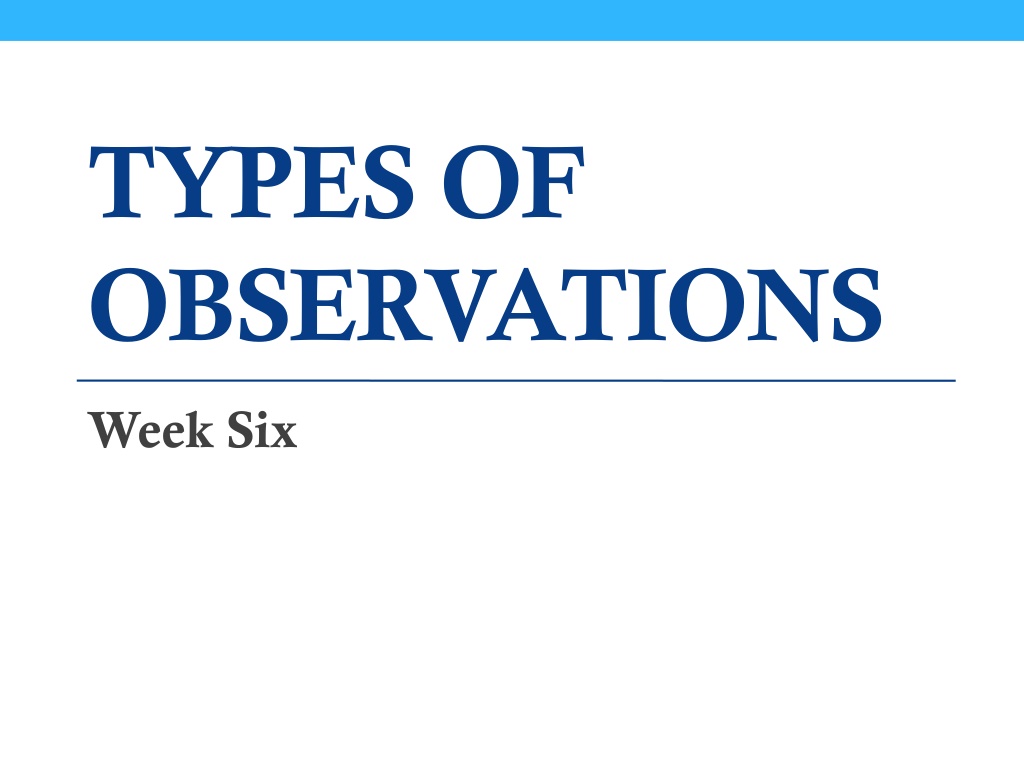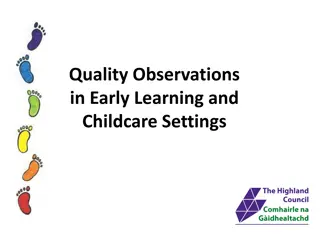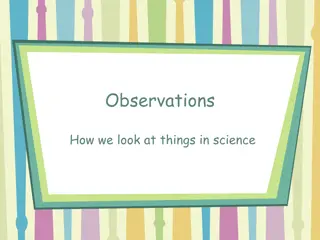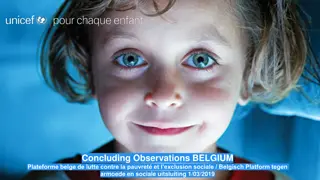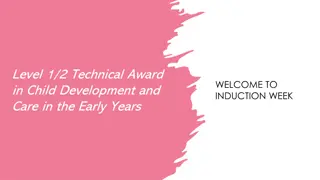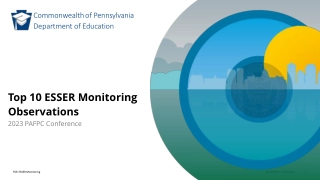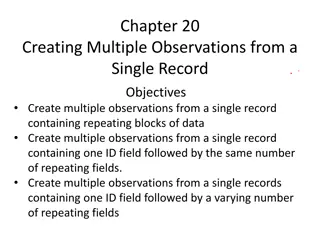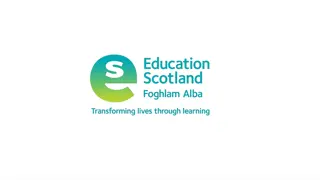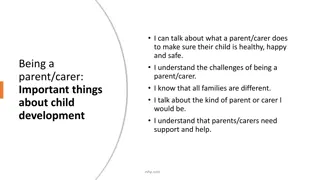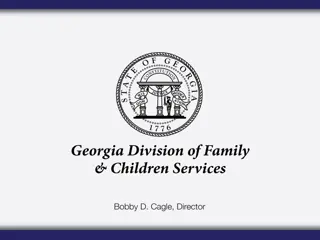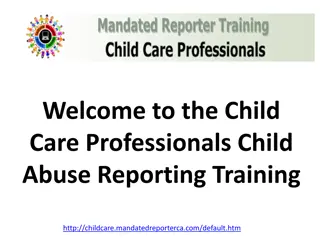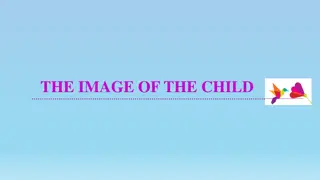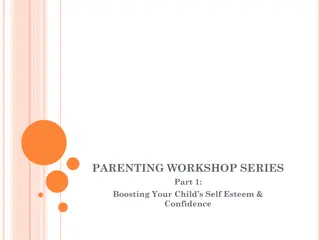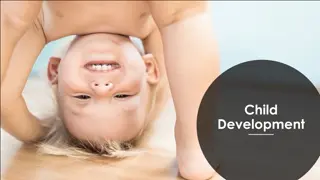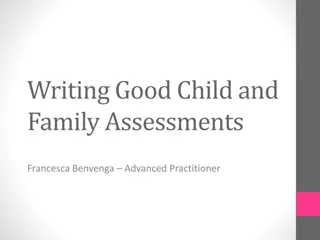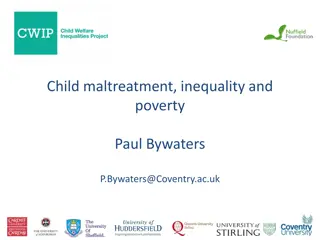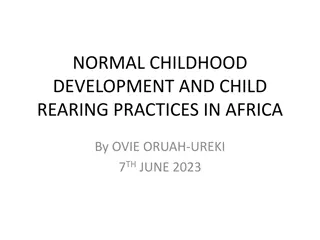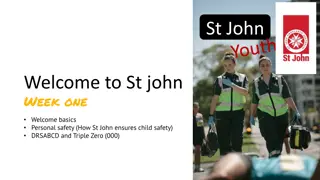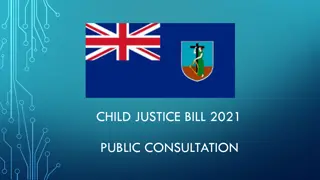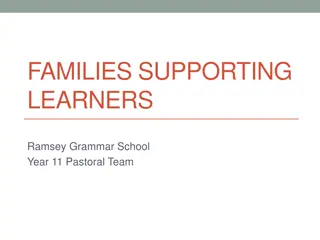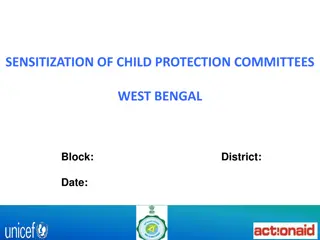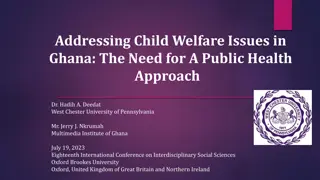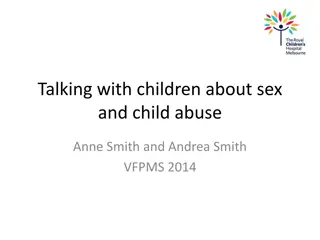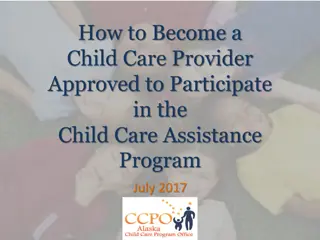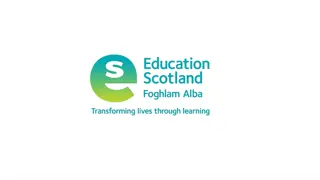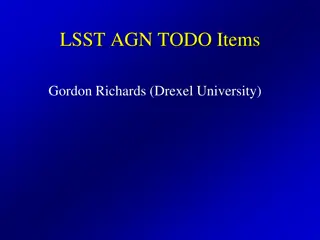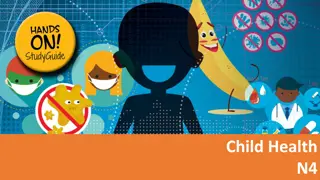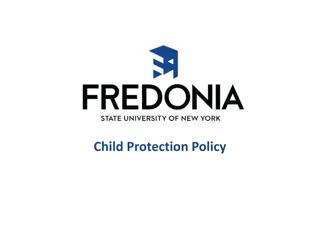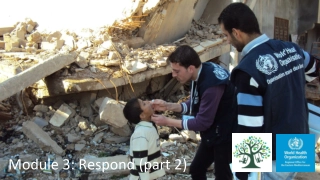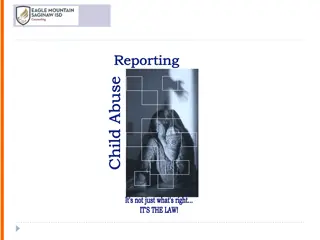Understanding Types of Observations in Child Development
Explore different types of observations such as anecdotal records, running records, time sampling, and more used in assessing children's behaviors and learning progress. Learn about detailed narrative observations and their importance in analyzing interactions and skill acquisition. Dive into examples of running records capturing a child's play activities and interactions with peers, offering insights into their development and relationships.
Download Presentation

Please find below an Image/Link to download the presentation.
The content on the website is provided AS IS for your information and personal use only. It may not be sold, licensed, or shared on other websites without obtaining consent from the author. Download presentation by click this link. If you encounter any issues during the download, it is possible that the publisher has removed the file from their server.
E N D
Presentation Transcript
TYPES OF OBSERVATIONS Week Six
Types of Observations 1. Anecdotal Record 2. Running Record 3. Time Sampling 4. Specimen Record 5. Event Sampling 6. Checklists 7. Rating Scale
Running Records/Narrative Observations These are very detailed descriptions of an event or behaviour which is recorded as it happens. They are recorded in present tense and provide step by step commentary of what is observed. They can be very helpful for closely analyzing interactions or a child's progress at acquiring particular skill/learning. Typically a running record records time in increments, although this is not always the case. The key objective is to be very detail and factual about what you see, recording things that at the time may seem meaningless, but could later help an observer breakdown or better understand the learning that is occurring.
Example: (9:15am) Jai is sitting in the sandpit. He is using a shovel in his right hand to dig sand and pour loose sand into a old cooking pot. He groans and digs again, lifts the spade (losing half of the sand) and pours into the pot. He digs again and lifts a scoop of damp sand and lifts it to the pot (his arm wobbles but he does not drop the sand). He swaps hands and digs with his left hand, but lifts the spade with his right hand (dropping sand again). Jai groans. Jai shovels the sand again with his right arm. Jai drops the shovel and pats the sand with his left hand and then his right. He picks up the shovel with his left hand, scoops a large scoop (wobbles and drops some sand) as he puts into his pot. He pats the sand again with this right hand and reshovels with his left hand.
Example: (9:19am) Jai looks up to see his friend Liam at the toy stove. He is watching Liam stir his pot. (9:21am )Jai says "Liam can you bake my cake". He gets up then squats and picks up his pot. Jai carries it to Liam. Jai drops the pot on the table with a heaving sigh. Liam looks at Jai and smiles and says "in a minute...my cake's not done yet". Jai walks over to the stove and looks in Liam's pot. He is on his tippy toes Jai says "Can I see?". "My cake has chocolate in it...see" Liam points to the mix. Jai giggles..."Yum" and grabs a handful of the mix, stepping away from the pot (about 3 paces) and pretends to eat it. The sand mix falls to the ground, Jai steps back as it falls. Jai walks forward with his hand reaching for the mix again (Jai is smiling). Liam steps in front of his pot (Liam is smiling) "You can't do that...you have to wait till it is cooked!"
Interpretation: Liam and Jai have developed a good friendship and are interacting together well. This activity showed that they enjoy dramatic pretend play of an activity they probably have both observed at home. Jai shows a preference for using his right arm/hand but is experimenting with his left.
Opportunities: To leverage Jai & Liam's interest in cooking into a mathematical cooking experience for counting and weighing ingredients. To provide other gross motor activities to build strength in Jai's left arm.
Types of Observations 1. Anecdotal Record 2. Running Record 3. Time Sampling 4. Specimen Record 5. Event Sampling 6. Checklists 7. Rating Scale
Time Sampling Time sampling is effectively the recording of a child's activities/behaviour at pre-determined regular intervals during the day. Typically time samples are conducted half hourly but the frequency can be as often or infrequent as is appropriate to the child and situation. Time samples can be very helpful in monitoring child's interactions, particularly if that child is quiet and overlooked or always shows a preference for only a few particular activities.
Time 9:15 am Location Main Playground Activities Sandpit/Cooking Pretend Play Interaction Liam 9:45 am Main Playground Dinosaur pit (rocks and plastic dinosaurs) Liam & Lachlan 10:15 am Main Playground Climbing Equipment Liam 10:45 am Kindergarten Room Blocks Declan 11:15 am Kindergarten Room Blocks Liam & Lachlan 11:35 am Kindergarten Room Dress ups Liam & Lachlan 11:45 am Kindergarten Room Dress ups Declan 12:05 pm Kindergarten Room Computer Declan
Interpretation: Liam friendship and are interacting together well, choosing to spend a large part of their day together. Jai shows a preference for active, dramatic and construction play. and Jai have developed a good
Opportunities: To leverage Jai enjoyment of pretend play (with LIam) into other activities he has not been observed yet to take an interest in such as art (eg. creation of spaceman/robot outfits using boxes, paint etc.)
Types of Observations 1. Anecdotal Record 2. Running Record 3. Time Sampling 4. Specimen Record 5. Event Sampling 6. Checklists 7. Rating Scale
Specimen Record The specimen record is very similar to a running record __________________________. records are usually recorded by outside observers. In a specimen record, the observer is often looking for a predefined behavior or interaction. Codes are used to signify children: M1=first male child M2=second male child T1=first teacher T2=second teacher Specimen
Types of Observations 1. Anecdotal Record 2. Running Record 3. Time Sampling 4. Specimen Record 5. Event Sampling 6. Checklists 7. Rating Scale
Event Sampling: Event sampling is a useful technique for observing behaviours, in particular for identifying the causes and possible consequences of certain behaviours, triggers and interactions. Event sampling is normally recorded using the "ABC" technique: A for Antecedent (possible triggers, behaviours, actions) immediately prior to the event; B for the Behaviour (a summary of the observed behaviour) C for the Consequences (what happened immediately after the behaviour/event.
ABC/Event Sampling: An example of an event sample which may be recorded using this method includes observing each time a child exhibits signs of aggressive behaviour and any causal factors. The knowledge gained from this observation would then likely be helpful in terms of identifying possible triggers.
Date: 1/11/2010 Time: 9:15am Observer: Natalie Location: Main Playground Child/Children: Jai (4.1 yrs) Liam (4 yrs) A B C Jai & Declan are playing blocks. Jai is building a tower. Declan gets up and asks Jai to come with him to play on the lego table. Jai does not respond. Declan come up behind Jai and wraps his arm around Jai. Jai cries "don't...you hurt me"..Declan says sorry but still pulls at Jai..."come on". Declan pulls Jai over. Jai looks up and pushes Declan away. Declan falls over and cries. Delcan gets up and runs to a teacher..."Jai pushed me" Jai turns away..."Declan hurt me"...Jai walks to the book corner on the other side of the room. Declan follows sits down beside Jai. Two minutes later both boys are smiling again.
Interpretation Jai and Declan are learning how to make decisions and direct theirs and others play. In this circumstance Declan was unable to physically force Jai to another activity. Opportunities To encourage discussion and/or read a story about listening and sharing (of your time/toys etc.)
Types of Observations 1. Anecdotal Record 2. Running Record 3. Time Sampling 4. Specimen Record 5. Event Sampling 6. Checklists 7. Rating Scale
Checklists and Rating Scales A checklist is a list of sequential behaviors arranged in a system of categories. The observer can use the checklist to determine whether the child exhibits the behaviors or skills listed. Rating scales are used to determine the degree to which the child exhibits a certain behavior or the quality of the behavior. Each trait is rated on a continuum.
Diary/Journal/Reflective Observations & Portfolios These are fantastic way of building up a picture of the whole child, the activities they participated in and their interests. Typically consisting of a compilation of photographs, work samples and summaries of the day. I particularly find them useful in group observations or integrating group observations with the individual. In many cases children (and families) can become involved in the portfolios production and in such cases it is important that the observations focus on the child's strengths. They can be time consuming and normally require regular compilation (although not compulsory).
Diary/Journal/Reflective Observations & Portfolios
What can I put in a Portfolio? Children's art work collected periodically throughout the year. Samples of children's writing such as in journals or with the case of very young children. Photographs of a child's block tower or snap block structure Photographs of children's cooperative work such as murals or the on-going record keeping and analysis of the temperature for a month. Numerous on-going assessment systems for young children are now available. These assessments guide the teacher's observations and offer a means to assess the curriculum to determine if children are being given opportunities to grow in all domains.
CODE OF ETHICS AND STANDARDS OF PRACTICE https://www.college-ece.ca/en/Documents Code%20of%20Ethics%20and%20Standards%20 of%20Practice%202013.pdf
Introducing Our Code of Ethics and Standards of Practice The purpose of the Standards of Practice is to provide assistance to members of the College of Early Childhood Educators (the College) and to promote excellence in their practice. The Standards of Practice set out standards of professional practice and conduct, while the Code of Ethics articulates ethical standards which apply to professional practice and conduct.
Introducing Our Code of Ethics and Standards of Practice The Standards of Practice apply to the breadth and scope of the practice of early childhood education. Throughout the scope of practice for the profession, there are variations in approaches and members vary their methods in response to the demands of a particular situation. The Standards of Practice prescribe the basis on which professional practice is conducted in a sound and ethical manner, regardless of the context in which that practice occurs.
Introducing Our Code of Ethics and Standards of Practice The College has established the following six standards dealing with specific issues in the practice of early childhood education: Caring and Nurturing Relationships that Support Learning Developmentally Appropriate Care and Education Safe, Healthy and Supportive Learning Environments Professional Knowledge and Competence Professional Boundaries, Dual Relationships and Con icts of Interest Confidentiality and Consent to the Release of Information Regarding Children and their Families
A. Responsibilities to Children Early Childhood Educators make the well-being and learning of all children who are under their professional supervision their foremost responsibility. They value the rights of the child, respecting the uniqueness, dignity and potential of each child, and strive to create learning environments in which children experience a sense of belonging. Early Childhood Educators are caring, empathetic, fair and act with integrity. Early Childhood Educators foster the joy of learning through play-based pedagogy.
B. Responsibilities to Families Early Childhood Educators value the centrality of the family to the health and well-being of children. They recognize and respect the uniqueness and diversity of families. Early Childhood Educators strive to establish and maintain reciprocal relationships with family members of children under their professional supervision. These relationships are based on trust, openness and respect for confidentiality. Early collaborate with families by exchanging knowledge and sharing practices and resources. Childhood Educators
C. Responsibilities to Colleagues and to the Profession Early Childhood Educators interact with colleagues and other professionals in ways that demonstrate respect, trust and integrity. Through their conduct, Early Childhood Educators strive to enhance the status of the profession in their workplaces and in the wider community. Early Childhood Educators value lifelong learning and commit themselves to engaging in continuous professional learning to enhance their practice. They support experienced colleagues, those who are new to the profession and students aspiring to the profession
D. Responsibilities to the Community and to Society Early Childhood Educators value and engage in collaboration with community agencies, schools and other professionals. Early Childhood Educators recognize that they contribute to community and society by advocating for and appreciation of the profession, children and early learning. promoting an
